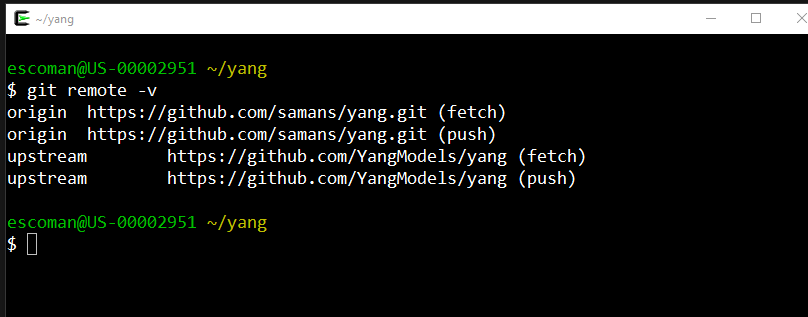
$ git pushĮxplore the following site for more information on the git push command and the available options - git push. The setting of upstream branches in Git is convenient because when one does a git fetch, new commits from the remote repository can be fetched, and then one can choose to merge those changes.Īnother use is that when one does a git pull (to get remote repository changes) or git push (to push changes to the remote repository), one no longer needs to provide the target branch in those commands.įor example, one can execute as follows to push the new changes to the remote repository. feature1 and main have upstream branches set. We will check the tracking branches of both the branches again, as follows.
#Set upstream origin master git password
$ git push -set-upstream origin feature1īranch 'feature1' set up to track remote branch 'feature1' from 'origin'. git push -set-upstream origin master Username for ' yourusername Password for ' remote: Support for password authentication was removed on August 13, 2021. I have to disable it after waiting for the screen to refresh, then i am able to use the UI. BUT now my UI is freezing, i am unable to interact with Obsidian while the plugin is working. Thus, now we will set up the upstream branch using the git push command with the -set-upstream option. I ran git push -set-upstream origin master and git commit, and the commit errors have gone. In comparison, the branch feature1 we just created has no tracking branch and has no upstream branch associated with it. We can see that the main branch has a tracking branch and an upstream branch associated with it.
We will now check the tracking branches using the git branch command with the -vv option. The easiest way to set an upstream branch is to use the '-set-upstream' option when pushing the branch to the remote repository for the first time: git push -set-upstream origin
#Set upstream origin master git code
So don't forget to commit code often, but even then, those commits aren't safe until your push them to your upstream branch.How to use Git A complete guide: Part 1 $ git checkout -b feature1 If your computer were to explode and you hadn't pushed your branch to the repository, your work would be gone forever. That will push your branch to your origin repository so that you as well as other teammates can access it at any time. You can instead call: git push -u origin master Step 2: Then merge the ‘origin/master’ to ‘master’. Master branch would be fetched to local and local copy would be called as origin/master. For example, if you have checked out foo branch, your HEAD now is foo. git branch -set-upstream-to origin/foo Add Git Upstream Using Git HEAD In git, HEAD refers to the currently active branch. It will enable tracking, and you will be able to pull the changes. Step 1: Fetch the remote branch ‘master’ from remote ‘origin’. To avoid this, you can set git upstream using the following command. There is also a shorthand version for those of us who don't like remembering long flags like -set-upstream. Below is the process to merge the origin/master to master branch on remote origin. If you are working on a branch called develop, this command would be: git push -set-upstream origin develop You can do this by using the command: git push -set-upstream origin To fix this error we need to add our branch to our repository.
 git push -u
git push -u Rebase is a good choice when no one except you has worked on your feature. I won't go into much details here, but merge is kinda safer and creates an additional commit that contains merged commits, whereas rebase is good for git log purists since it doesn't create a commit upstream is merged. if you try to run git push on a branch that isn't in your remote repository yet. The easiest way to set the upstream branch is to use the git push command with the -u option for upstream branch. There's a lot of debate on git rebase vs git merge. This is why you get the error The current branch master has no upstream branch.
When you are working on a new branch, the remote repository doesn't know about it yet. We can use git push which will only when the user has the write access to send our work to the upstream from which we have cloned which will be origin remote. When you try to checkout a branch, you pull this remote branch from your repository. To push the current branch and set the remote as upstream, useĪn upstream branch is a remote branch that is hosted in a remote repository, such as GitHub or Bitbucket. Sometimes when attempting to git push you can run into this error: fatal: The current branch master has no upstream branch.


 0 kommentar(er)
0 kommentar(er)
